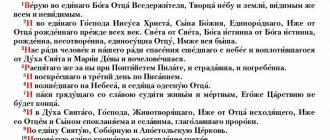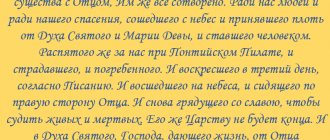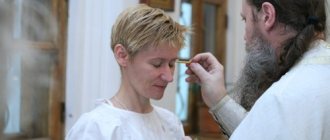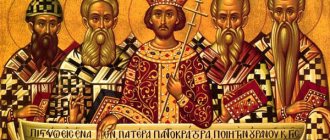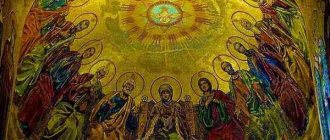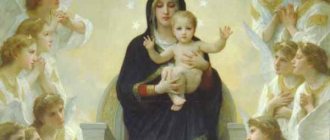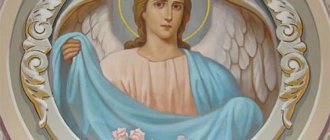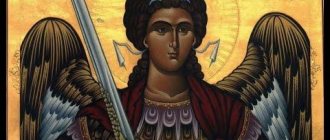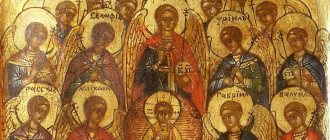- “I believe in one God, the Father, Almighty, Creator of heaven and earth, of everything visible and invisible.
- And in one Lord Jesus Christ, the Son of God, the Only Begotten, begotten of the Father before all ages: Light from Light, true God from true God, begotten, not created, one being with the Father, by Him all things were created.
- For the sake of us people and for the sake of our salvation, He came down from heaven, and took flesh from the Holy Spirit and the Virgin Mary, and became human.
- He was crucified for us under Pontius Pilate, and suffered, and was buried.
- And rose again on the third day according to the Scriptures.
- And ascended into heaven, and sits at the right hand of the Father.
- And He will come again with glory to judge the living and the dead; His Kingdom will have no end.
- And in the Holy Spirit, the Lord, the giver of life, who proceeds from the Father, worshiped and glorified with the Father and the Son, who spoke through the prophets.
- Into one holy, catholic and apostolic Church.
- I recognize one baptism for the forgiveness of sins.
- I'm waiting for the resurrection of the dead
- and the life of the next century. Amen (truly so)."
The Creed in Church Slavonic (be sure to read, since in most churches this version of the text is provided at baptism):
- “I believe in one God, the Father, Almighty, Creator of heaven and earth, visible to all and invisible.
- And in one Lord Jesus Christ, the Son of God, the only begotten, who was born of the Father before all ages; Light from Light, true God from true God, begotten, uncreated, consubstantial with the Father, to whom all things were.
- For our sake, man and our salvation, who came down from heaven and became incarnate from the Holy Spirit and the Virgin Mary and became human.
- Crucified for us under Pontius Pilate, and suffered and was buried.
- And he rose again on the third day according to the Scriptures.
- And ascended into Heaven, and sits at the right hand of the Father.
- And the one who is to come will judge with glory the living and the dead, His Kingdom will have no end.
- And in the Holy Spirit, the Lord, the Life-Giving One, who proceeds from the Father, who is with the Father and the Son, we are worshiped and glorified, who spoke the prophets.
- Into one Holy, Catholic and Apostolic Church.
- I confess one baptism for the remission of sins.
- Teaching the resurrection of the dead,
- and the life of the next century. Amen."
To be precise, the Creed is not exactly a prayer, but a dogmatic teaching of the Orthodox Church.
Unchangeable rules and the basis of the Christian faith, given by the apostles. They were formulated at the 1st and 2nd Ecumenical Council, although in fact they were used during baptism by the first Christians. At the Councils of Nicaea and Constantinople they approved and collected together the true sayings, declaring that changing the Creed is considered heresy (false delusion). This “prayer” is read:
- at every liturgy (since the 6th century) all members of the church speak aloud;
- as part of the home morning Rules;
- as one of the prayers, a short household rule given by Seraphim of Sarov.
Note: If you ask an Orthodox Christian what he believes in, then it is enough to quote a Symbol that churchgoers know by heart, like the Our Father or the Virgin Mary.
What is
The prayer “Creed” sets out the Christian doctrine in an abbreviated form. It consists of 12 sentences, starting with the word “I believe.” In the early Christian period and today, everyone who underwent the rite of baptism had to know it by heart. It is read by the clergyman at the beginning and end of the ceremony and by the convert.
The christening of infants does not differ from the sacrament of adults in meaning, but instead of the foolish ones, one of the godparents reads the prayer. If the baby is a girl, then the godmother reads it, if the baby is a boy, then the godfather reads it. The child has spiritual mentors who pray for him and show care. The choice of godparents requires a serious approach: they must be Orthodox believers who attend church and fulfill the commandments of the Lord. The prayer at the ceremony is said by heart or a prayer book is used.
Akathists
The site provides a brief overview of the Creed. In the future, the site will be updated with interpretations of akathists and video clips will be made on these akathists.
When reading the akathist at home, it is advisable to take a blessing from the priest. You can read the akathist at a time convenient for you. The reading of the initial prayers begins as in morning and evening prayers, the end of the reading of the akathist also ends with prayers as in morning and evening prayers.
Akathist is a hymn, glorification of God, the Holy One. As a rule, reading is done standing. But, if you are weak, sick, or cannot stand in front of the icon, you can, for example, listen to the akathist at lunchtime at work. Then, of course, you will not be able to strictly follow all the rules.
What matters is that your heart truly desires to glorify the Lord. Therefore, as the Apostle Paul said: “Pray without ceasing” (1 Thess. 5:17). Nothing should be an obstacle to prayer.
Meaning and interpretation of each part
Every word in the prayer “Creed” is filled with deep meaning, since it sets out the essence of Christianity in the most condensed form.
- The prayer of the creed begins with the word “I believe,” which applies to all subsequent parts of the text. I believe - that means I feel God within myself without logical evidence of reason, visual, auditory, tactile signals. The continuation of the prayer of “one God” means that life and its manifestations are given by God, and are not his reflection, as in paganism. The connection with the world is characterized as the relationship of a loving Father to his brainchild: “God the Father.” His unconditional role is emphasized by the words “Almighty, Creator of heaven and earth, everything visible and invisible.”
- The second part of the prayer speaks of a single leader (Lord), the bearer of divine will on Earth - Jesus Christ. Christ or Messiah is the savior of the world from sin. Jesus Christ is the son of God, the Only Begotten, and not created like Adam and Eve. Therefore Jesus is God. He received the human essence that connected him with other people from his mother, the Virgin Mary.
- The role of Jesus Christ is briefly and succinctly indicated: He came into the world to save it from destruction. The world, created by love and in the name of love, was transformed as a result of a substitution: under the guise of good, evil began to rule the world. People no longer feel that instead of love there is a war of all against all, that the world is heading towards death and decay.
- This part mentions Pontius Pilate - the man who gave the criminal order. He was clothed with the power of the Roman Caesar and had freedom of choice, but he was afraid of the evil crowd and, knowing that Jesus was innocent, decided to execute him. The two communions “suffered and buried” contain all the torment that the Son of God endured before death, and the triumph of life before death. There is no word “dead” in the prayer, which foreshadows his resurrection. Every person has a choice whether to accept salvation through the suffering of Christ or not. The essence of Christian doctrine lies in the beginning of the phrase “crucified...”. God in the form of a man came into the world with love and was rejected and innocently executed. Evil people hated him because he radiated goodness and love, but they could not overcome their vices.
- Belief in the resurrection of Christ is the cornerstone of Christianity. This is its main difference from religions that talk about the immortal soul and the perishability of the physical shell. Christ rose as a man, and not an ephemeral entity. “I believe” at the beginning of the Creed means that Christians believe in their resurrection in physical form.
- The words about ascension to heaven should be understood not figuratively, but as the spiritual side of life. In Christianity, the earth is matter, the sky is spirituality, where God reigns. Jesus Christ was reunited with the Father by rising from death.
- One phrase summarizes what the attitude of Christians should be towards their life and death. The Kingdom of God is not a gathering place for the righteous; it must be in every believer who lives according to the laws of goodness, love, beauty, and perfection. The second coming of Christ does not mean the judgment of the master over the slaves, but the consciousness of Christians of their spiritual imperfection, purifying fear and repentance.
- “I also believe in the Holy Spirit...” God the Father is the source/emitter of love, Jesus Christ is his successor, the Holy Spirit is a gift/love that enlightens the soul and mind. He descends on the chosen ones (prophets), through whom holy truths reach people.
- This part describes the church:
- united - united by doctrine and faith;
- saint – cleansing people from sins;
- conciliar - addressed to the whole world, and not to individual nations;
- apostolic - the teachings of Christ were and are carried to people by the apostles chosen by God. Church, translated from Greek, means “gathering of those who are called,” that is, believers.
- Faith in baptism is faith in the sacrament that immersion in water in the name of the Father and the Son and the Holy Spirit brings one closer to God and gives hope for the forgiveness of sins.
- /12. The prayer ends with the word “tea” (waiting) for “the resurrection of the dead.” It must be understood as the completion of a logical chain: I want, I love, I’m waiting.
The “Creed” prayer is not about the well-being of a Christian, but about the recognition of his imperfection, sinfulness and repentance.
History of appearance
Before his ascension to God the Father, Jesus Christ turned to the apostles so that in his place they would carry the creed to people, baptizing them in the name of the Father and the Son and the Holy Spirit. Each convert had to renounce his previous views and accept Christianity. There was a need to unify prayer. In addition, interpretations of the Gospel and new movements in Christianity appeared.
Church clergy realized that it was necessary to create a dogma of faith that would define the Christian religion.
To solve this problem, the Third Ecumenical Council was convened:
- in Nicaea (325);
- Constantinople (385);
- Ephesus (431).
The contradictions between the bishops ended with the approval of the “Creed” prayer: at the first council 7 provisions were adopted, at the second – 5, at the third it was determined that it was not subject to further additions. After 6 centuries, as a result of dogmatic disagreements, a split occurred into the Orthodox and Catholic churches.
Full text
The prayer “Creed” is read daily, in the morning and evening rules, and sung during the morning liturgy with the parishioners. Every Orthodox believer should understand its meaning.
In Church Slavonic
Text in Old Church Slavonic:
- I believe in one God the Father, Almighty, Creator of heaven and earth, visible to all and invisible. 2. And in one Lord Jesus Christ, the Son of God, the only begotten, who was born of the Father before all ages, Light from Light, true God from true God, begotten, uncreated, consubstantial with the Father, by whom all things were. 3. For us, for the sake of man and for our salvation, he came down from heaven and became incarnate from the Holy Spirit and the Virgin Mary, and became human. 4. She was crucified for us under Pontius Pilate, and suffered and was buried. 5. And he was raised on the third day according to the Scriptures. 6. And ascended into heaven, and sits at the right hand of the Father. 7. And again the coming one will be judged with glory by the living and the dead, His Kingdom will have no end. 8. And in the Holy Spirit, the Lord, the Life-Giving One, who proceeds from the Father, who is with the Father and the Son, is worshiped and glorified, who spoke the prophets. 9. Into one Holy, Catholic and Apostolic Church. 10. I confess one baptism for the remission of sins. 11. I look forward to the resurrection of the dead, 12. and in the life of the next century. Amen.
Translation into Russian
The prayer of the creed, presented in modern Russian:
- I believe in one God, the Father, Almighty, Creator of heaven and earth, of everything visible and invisible. 2. And in one Lord Jesus Christ, the Son of God, the Only Begotten, begotten of the Father before all ages: Light from Light, true God from true God, begotten, not made, one being with the Father, by Him all things were created. 3. For the sake of us people and for the sake of our salvation, he came down from heaven, and took flesh from the Holy Spirit and the Virgin Mary, and became a man. 4. He was crucified for us under Pontius Pilate, and suffered, and was buried. 5. And rose again on the third day according to the Scriptures. 6. And ascended into heaven, and sat at the right hand of the Father. 7. And He will come again with glory to judge the living and the dead; His Kingdom will have no end. 8. And in the Holy Spirit, the Lord, the giver of life, who proceeds from the Father, worshiped and glorified with the Father and the Son, who spoke through the prophets. 9. Into one holy, catholic and apostolic Church. 10. I acknowledge one baptism for the forgiveness of sins. 11. I look forward to the resurrection of the dead, 12. and the life of the age to come. Amen (truly so).
About the members of the Creed
How many parts are there in a creed?
To better understand the Ecumenical Creed, we should pay attention to its division into twelve members, or parts, and consider each member separately.
What does each part of the creed say?
Each part talks about:
1 God, the First Hypostasis of the Holy Trinity - God the Father, Creator of the world. 2 Second Person of the Holy Trinity, about the Lord Jesus Christ, the Son of God. 3 Incarnation of the Son of God. 4 the suffering and death of Jesus Christ. 5 The Resurrection of Jesus Christ. 6 The Ascension of Jesus Christ into Heaven. 7 The Second Coming of Jesus Christ to earth. 8 Third Hypostasis of the Holy Trinity, about the Holy Spirit. 10 Baptism, where other Sacraments are also implied. 11 future (universal) Resurrection of the dead. 12 Eternal Life.
Additional prayers at baptism
During the baptism ceremony of a baby, godparents can offer prayers from the bottom of their hearts on his behalf and on their own. After baptism, the child will have a guardian angel who will be next to him throughout his earthly life.
Lord Jesus Christ
Who is worshiped and glorified at all times and at every hour, in heaven and on earth, Christ God, long-suffering, abundantly merciful, abundantly gracious: who loves the righteous and has mercy on sinners, who calls everyone to salvation with promises for future blessings. Yourself, Lord, accept our prayer at this hour, and correct our belly to Your commandments; Sanctify our souls, cleanse our bodies, correct our thoughts, cleanse our thoughts; and deliver us from all sorrow, evil and disease: protect us with your holy angels, so that by guarding and instructing them, we may reach the union of faith, and the mind of your impregnable glory: for blessed art thou unto the ages of ages. Amen.
About the living
Save, Lord, and have mercy on my spiritual father (name), my parents (names), relatives (names), bosses, mentors, benefactors (names) and all Orthodox Christians.
To the Honest Cross
May God rise again, and may His enemies be scattered, and may those who hate Him flee from His presence. As smoke disappears, let them disappear; just as wax melts in the face of fire, so let demons perish from the face of those who love God and signify themselves with the sign of the cross, and who say in joy: Rejoice, Most Honorable and Life-Giving Cross of the Lord, drive away the demons by force on you of our Lord Jesus Christ, who descended into hell and straightened the power the devil and gave us to you, Your Honest Cross, to drive away every adversary. O Most Honest and Life-Giving Cross of the Lord! Help me with the Holy Virgin Mary and with all the saints forever. Amen.
About the deceased
Rest, O Lord, the souls of Your departed servants: my parents, relatives, benefactors (names) and all Orthodox Christians, and forgive them all sins, voluntary and involuntary, and grant them the Kingdom of Heaven.
Pre-initial
Lord Jesus Christ, Son of God, prayer for the sake of Your Most Pure Mother and all the saints, have mercy on us. Amen.
By agreement
Prayer by agreement is when two Orthodox Christians simultaneously offer a prayer to God in order to save a third person from illness or adversity. In their appeal, they talk about mercy, so that God will listen to their request for the sake of someone.
Rules for preparing for the sacrament of baptism
A child is baptized not so that he grows up obedient and healthy, but according to the faith of his parents, who wish him salvation and God’s Grace.
Preparation for the sacrament consists of several stages:
- choosing a name;
- dates of baptism;
- places;
- godparents;
- purchasing baptismal supplies.
The sacrament itself lasts from half an hour to 40 minutes. All necessary preparations will take about 7 days. If the child’s name is not in the calendar, then he will be given the one that falls on the date of baptism. It is believed that a newborn can be baptized no earlier than after 40 days, since the mother cannot enter the temple before this period. But, under certain circumstances, you can be baptized earlier. The time of year does not matter: a comfortable temperature is maintained in the baptismal department, and the water is heated.
The choice of church depends on the wishes of the parents. First of all, you need to talk to the priest, find out about the conditions and the availability of a queue. The Orthodox religion does not prohibit a child from having one godfather. Married couples, monks/nuns, and children under 14 years old cannot be godparents. Baptismal clothes for a boy - blue shirt, cap, towel. The girl has a pink dress, scarf, and towel. For both babies it can be white.
When to read “I Believe in One God”
Just 150 years ago, singing prayers was considered blasphemy and was prohibited. They were only allowed to be read. Now the situation is different and sacred words can be pronounced both by chanting and reading. It is necessary to pray early in the morning or before going to bed. It is recommended to pray when you realize that faith is weakening, that there is practically nothing good and pure left in your soul. Her lines are filled with positive energy. If you perceive it not as an obligation, but as a heavenly parting word, it will protect you from temptations and adversity.
Since this prayer was originally associated with baptism, when performing this rite it must be read to one of the godparents. If a mature person is baptized, then he must pray on his own.
The most important thing is to turn to the sacred text only when you are spiritually prepared to talk with God; it is very important to believe that he hears you.
About the author About the book
This prayer contains the whole essence of the Christian faith, which is of great importance for Christians themselves. It is a clue to the main principles of religion. If a person doubts, then it will help to rediscover faith in God.
